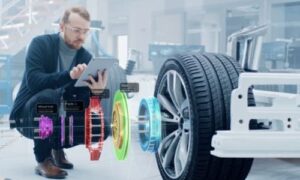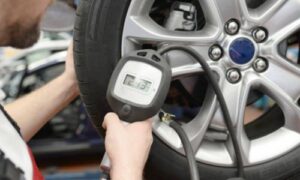Solar auto glass is a groundbreaking innovation that has the potential to revolutionize the automotive industry. By harnessing the sun’s power, this technology allows vehicles to generate electricity, reducing their reliance on fossil fuels and decreasing their carbon footprint. This green solution benefits the environment and offers cost savings for vehicle owners in the long run.
Introduction
The automotive industry has recently witnessed a significant shift towards sustainable and eco-friendly technologies. One such innovation making waves is solar-powered auto glass. This groundbreaking development addresses environmental concerns and offers a unique blend of functionality and green energy. In this blog post, we will delve into the world of Solar-powered auto glass, exploring its benefits, challenges, and potential for transforming the automotive landscape.
Understanding Solar Auto Glass
Understanding Solar Auto Glass is crucial to grasp its potential for revolutionizing the automotive industry. Solar glass for automobiles refers to specially designed windows equipped with photovoltaic cells, allowing them to convert sunlight into electricity.
What is Solar Auto Glass?
Solar-powered auto glass, also known as photovoltaic auto glass, integrates photovoltaic cells into the windshield and windows of a vehicle. These cells harness sunlight to generate electrical power, which can be used to supplement the vehicle’s energy needs. The concept is akin to solar panels on rooftops but tailored for the automotive sector. Solar auto glass is a sustainable and innovative solution that provides energy for the vehicle and reduces its carbon footprint. By harnessing the sun’s power, vehicles equipped with solar auto glass can potentially rely less on traditional fuel sources, leading to a more environmentally friendly transportation system.
How Does Solar Glass Work for Automobiles?
The solar cells in the auto glass convert sunlight into electricity through the photovoltaic effect. These cells are usually thin and transparent, allowing natural light to pass through while capturing solar energy. The generated electricity can power various vehicle components, such as the air conditioning and entertainment systems, or even charge the electric vehicle’s battery. In addition to reducing reliance on fossil fuels, solar auto glass also helps to decrease greenhouse gas emissions and overall carbon footprint. This innovative technology promotes sustainability and offers potential cost savings by reducing the need for traditional energy sources.
The Importance of Solar Glass for Automobiles
The utilization of laminated glass imparts exceptional strength to car windshields. But when combined with solar control features through a special polyvinyl-butyral (PVB) interlayer, laminated glass becomes a powerful way to deal with problems in your car caused by heat.
Below are the key important factors of solar glass in cars:
1. Enhanced Fuel Efficiency
The relentless summer heat in India can turn car interiors into intolerable spaces, leading to excessive use of air conditioning. Solar glass mitigates this issue by reducing the influx of heat, subsequently lowering energy consumption. Decreased air-conditioning usage translates to improved fuel efficiency, contributing to reduced CO2 emissions and lower energy bills.
2. Superior Comfort
Securing shaded parking spots is not always feasible. In such scenarios, the heat trapped inside a car takes considerable time to dissipate, creating an uncomfortable environment. A windshield coated with solar control technology can absorb the sun’s Infrared (IR) rays responsible for excess heat, effectively lowering the internal temperature of the car and enhancing overall comfort.
3. UV Protection
The sun’s detrimental ultraviolet (UV) rays pose various health risks, including sunburn, premature skin ageing, eye damage, and, in severe cases, skin cancer. Solar glass acts as a barrier, blocking solar radiation and safeguarding occupants from these harmful effects, ensuring a safer and healthier driving experience.
4. Extended Upholstery Lifespan
Continuous exposure to intense sunlight can gradually degrade the appearance of car upholstery. Installing solar glass for the windshield acts as a shield, protecting the upholstery from prolonged exposure to high temperatures. Additionally, it safeguards other items often stored in the car, such as sunglasses and water bottles, contributing to the interior’s and personal belongings’ longevity.
Advantages of Solar-Powered Auto Glass
The advantages of solar glass for automobiles include reducing the reliance on traditional fuel sources, decreasing carbon emissions, and saving money on fuel costs. Additionally, solar auto glass can help extend the battery life of electric vehicles by providing a continuous source of renewable energy.
1. Sustainable Energy Source
Solar auto glass taps into a clean, renewable energy source – the sun. This means that the energy generated by solar glass for automobiles is sustainable and does not contribute to the depletion of natural resources. It also reduces the dependence on fossil fuels, which are finite and harmful to the environment. By harnessing solar power, vehicles equipped with this technology contribute to reducing reliance on traditional energy sources and decreasing their carbon footprint.
2. Increased Energy Efficiency
Supplementing a vehicle’s power needs with solar energy enhances overall energy efficiency. This is because solar auto glass allows for the conversion of sunlight into electricity. This can power various vehicle functions such as air conditioning, lighting, and even charging electronic devices. By utilizing solar energy, vehicles can optimize their energy usage and reduce the strain on their traditional fuel sources, leading to improved fuel efficiency and longer battery life. Additionally, using solar power in vehicles can help reduce greenhouse gas emissions. It is associated with traditional energy production methods. This is particularly beneficial for electric vehicles, as the additional energy can extend their range and reduce reliance on external charging infrastructure.
3. Cost Savings for Users
While the initial cost of installing solar auto glass might be a consideration, users stand to benefit from long-term cost savings. Solar auto glass can significantly reduce the need for fuel or electricity to power vehicles, resulting in lower fuel or charging costs over time. Additionally, traditional auto glass’s maintenance and replacement costs can be reduced as solar glass for automobiles is designed to be durable and long-lasting for automobiles. The reduced reliance on conventional energy sources can lead to lower fuel or electricity bills, making the technology economically attractive.
4. Environmental Impact
Utilizing solar energy in transportation contributes to a cleaner environment by reducing greenhouse gas emissions. Solar glass for automobiles helps reduce greenhouse gas emissions by harnessing the sun’s power to generate electricity, which can be used to power various components of the vehicle. This reduces the need for fossil fuels and helps to mitigate air pollution and climate change. As the automotive industry continues to seek sustainable solutions, solar auto glass emerges as a promising avenue for minimizing the environmental impact of vehicle operation.
Challenges and Considerations
1. Efficiency Concerns
One of the challenges associated with solar glass is optimizing efficiency. The limited surface area of a vehicle’s windows constrains the energy generated. Researchers and manufacturers are actively working to improve the efficiency of solar cells to maximize energy production. Additionally, advancements in solar panel technology include developing thin-film solar cells. It explores increasing the energy conversion efficiency of solar glass for automobiles. Solar glass can be integrated with other renewable energy sources, such as rooftop solar panels. It also helps overcome surface area limitations and further enhances overall energy generation.
2. Integration with Vehicle Design
Integrating solar auto glass seamlessly into vehicle design is crucial for widespread adoption. Manufacturers need to strike a balance between aesthetics and functionality to ensure that solar panels do not compromise the overall look and feel of the vehicle. In addition, integrating solar glass for automobiles should consider factors such as durability and safety to meet the standards required for automotive use. By addressing these challenges, solar panels can become a practical and attractive vehicle feature, contributing to a more sustainable transportation system.
3. Weather and Environmental Factors
Weather conditions and environmental factors influence the efficiency of solar cells. Overcast skies or shading from buildings and trees can reduce the sunlight reaching the solar glass for automobiles, impacting its ability to generate electricity. Technology innovation is required to mitigate these challenges these days. One possible solution is the development of solar panels that are more resistant to shading. It allows them to still generate electricity even in partially shaded conditions. Additionally, energy storage system advancements can help store excess energy generated during optimal conditions. It also ensures a consistent power supply for the vehicle, even during periods of low sunlight.
The Future of Solar Glass for Automobiles
As technology advances and consumer preferences shift towards sustainable options, the future of solar auto glass appears promising. Ongoing research and development efforts are focused on improving efficiency, durability, and affordability. Additionally, collaborations between automotive manufacturers and renewable energy companies are likely to drive innovation and accelerate the integration of solar auto glass into mainstream vehicles.
FAQs about Solar Auto Glass
Q1: How much electricity can solar auto glass generate?
A1: The amount of electricity generated by solar auto glass depends on factors such as sunlight exposure—the glass’s surface area and the solar cells’ efficiency. On average, it can contribute enough power to support auxiliary systems in a vehicle.
Q2: Can solar auto glass charge an electric vehicle’s main battery?
A2: The current technology may not fully charge an electric vehicle’s battery. Solar glass for automobiles can contribute to charging and extend the vehicle’s range. It is a supplementary power source, reducing the reliance on external charging infrastructure.
Q3: Is solar auto glass durable and safe?
A3: Manufacturers design solar auto glass to meet safety standards and ensure durability. The solar cells are typically encased within the glass, protecting them from damage. Additionally, advancements in materials contribute to the overall safety and longevity of solar auto glass.
Q4: Does solar auto glass work in all weather conditions?
A4: Weather conditions can impact how well solar auto glass captures sunlight. While it may not perform optimally in overcast environments, advancements enhance its functionality in diverse weather conditions. For example, some solar auto glass technology designs still generate electricity even in low light conditions. Additionally, using anti-reflective coatings on the glass can help improve its performance in various weather conditions.
Q5: What other factors can affect the performance of solar glass?
A5: Some factors are the angle and orientation of the glass towards the sun, the cleanliness of the glass surface, and the temperature. The angle and orientation can determine how much sunlight directly hits the glass. At the same time, a clean surface allows for maximum light absorption. Additionally, extreme temperatures can affect the efficiency of solar glass for automobiles. Very high or low temperatures can impact its electrical conductivity.
Conclusion
Solar-powered auto glass represents a promising leap toward sustainable transportation. The automotive industry continues to embrace environmentally friendly solutions. Integrating solar technology into vehicles is poised to revolutionize how we drive. While challenges exist, ongoing research and development efforts and consumer awareness are paving the way for a greener and more energy-efficient future on the roads. Stay tuned as solar auto glass evolves, offering a shining example of innovation in the automotive landscape. Solar glass for automobiles, also known as photovoltaic glass, has the potential to harness sunlight. This converts it into electricity to power various vehicle functions.
Read More Blogs:






